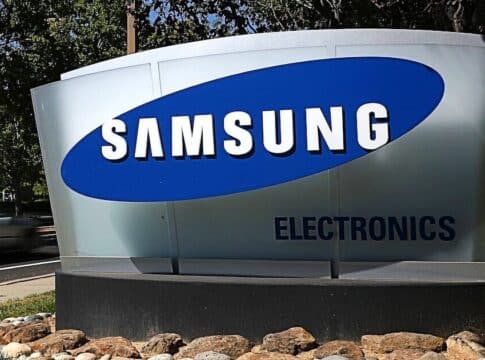Samsung Reports Net Zero Progress, Pledges Over $5B by 2030
Samsung Electronics, the world’s biggest mobile phone maker, is almost a third through its goal to be net zero as it ramped up its sustainability efforts in 2022 and pledged more than $5 billion to decarbonize its consumer electronics operation.
The South Korean tech major achieves 31% in its transition to meet its target by 2030, up 11% from 2021.
Samsung’s Carbon Emissions
Technology companies, which have a significant impact on people and economies, have also been one of the largest carbon emitters. The industry has a carbon emission of 2%-3% of global emissions in 2021, which is close to aviation’s footprint.
But the tech sector has been spending huge efforts in cutting down its carbon footprint, with major companies committed to slashing their carbon emissions and targeting net zero emissions.
Among the major tech companies, Samsung has the biggest footprint of over 20 million metric tonnes (Mt) of CO2 equivalent in 2021.
Samsung Electronics strongly rely on fossil fuels, which is significantly responsible for its carbon footprint. More than 80% of its power consumption is from non-renewable, fossil-fuel-based sources. Both its Scope 1 and 2 emissions for constructing manufacturing lines have been rising as shown below.
Another research by Electrics Hub further shows that the Seoul-based company emits more pollution than any other tech company. Its carbon footprint is equivalent to the emissions of 4.3 million cars on the road each year.
According to the same report, Amazon, the world’s biggest e-commerce firm, came second with 16.2 million Mt of CO2. This makes the giant retailer the largest polluter among the “Big Five” tech companies, including Alphabet, Apple, Meta, and Microsoft. The four remaining companies emitted much lower CO2e compared to Samsung.
They emitted 6.6 million, 1.0 million, 3.1 million, and 4.9 million Mt of CO2e, respectively.
The tech industry has a crucial role to play in the world’s quest to net zero emissions by 2050. The major players, in particular, have a big influence in impacting the sector’s transition to a low-carbon future.
Thus, the shift towards a climate-focused company means Samsung has a huge task to do. Its latest Sustainability Report outlines the ways in which the company has been tackling this matter.
Samsung’s Net Zero Pledge and Strategy
Samsung has committed to net zero emissions by 2050, pledging over $5 billion to decarbonize its consumer electronics operation.
Still, that target is 10-20 years later than Apple, Google, and Amazon. Apple aims to reach net zero by 2030, Google by 2030, and Amazon by 2040.
Yet, Samsung has set various ambitious goals as part of its net zero strategy. Highlighting its commitment to sustainability, Jong-hee Han, chief executive and vice chairman of Samsung noted in its report:
“Growing environmental and socio-economic risks coupled with geopolitical uncertainties have reinforced our belief that sustainability needs to be a key force for driving our competitiveness and technological innovation… We aim to mitigate carbon emissions by using our innovative technologies and maximising resource circularity across the life cycle of our products.”
A big part of its sustainability and net zero quest is Samsung’s “New Environmental Strategy” launched in September last year. It aims to tackle global environmental issues through its technologies.
The initiative has three major pillars, namely:
Joining the global drive to fight climate change,
Supporting the implementation of a circular economy, and
Addressing environmental challenges through technological innovation.
In particular, the tech major plans to boost the share of renewables in its energy mix. For its Southwest Asia operations, Samsung aimed to match electricity consumption with renewable energy production by 2022. That goal comes later for Central and Latin America and Africa, by 2025 and 2027, respectively.
Samsung has already achieved this target in China, the U.S. and Europe.
Moreover, the tech giant will further invest in new technologies that reduce process gasses produced by semiconductor manufacturing. It’s one of the areas that account for most of Samsung’s emissions. The company hopes to implement the necessary technology in its production facilities by 2030.
Other net zero strategies of Samsung are to:
optimize the energy efficiency of its products,
increase water recycling during manufacturing, and
develop carbon capture technology.
For unavoidable emissions, Samsung are buying carbon offset credits as part of its climate adaptation efforts since 2013. These carbon credits are from different carbon reduction projects, including low-carbon cooking stoves, landfill gas treatment, and nature-based solution projects.
Here are the firm’s net zero and sustainability targets at a glance.
How Does Samsung Progress Towards Net Zero?
Samsung shows that it’s serious about its net zero pledge and is making strides toward it.
In 2022, the company achieved 10.16 million tonnes of CO₂e reduction (Scopes 1 and 2) compared to 2019 levels. That’s a whopping 59% increase from the previous year.
Also, the tech giant became a member of the RE100, a global movement pursuing a 100% renewable energy system.
This commitment was proven by completing its transition to using renewables in Samsung’s Device eXperience (DX) divisions in Brazil, India and Vietnam. This is in line with the largest smartphone maker’s plan to utilize sustainable energy at its sites outside South Korea.
DX is the division that is making the Apple iPhone’s rival Galaxy smartphone series.
The South Korean major reported 8,704GWh of renewable energy consumed globally, reaching a transition rate of 31%.
Moreover, Samsung has increased the amount of recycled resin in its product and packaging plastic components by 200% (99,000 tonnes). Its Galaxy S6 phone is made with 99.9% recyclable material and comes in recyclable packaging. This innovation won the Sustainable Materials Management (SMM) Champion Award by the US Environmental Protection Agency.
It also puts the company on track with its target of using recycled resin in 50% of plastic parts by 2030 and in all plastic components by 2050.
When it comes to water resource preservation, Samsung managed to reuse 117 million tonnes of water in 2022, up 29% from 2021.
Lastly, the major tech company is working with various organizations to further improve its sustainability efforts. For instance, it partnered with the popular brand Patagonia to make a washing machine that minimizes the environmental impact of microplastics.
To make its net zero ambition a reality, Samsung will invest $5.3 billion in those strategies by 2030. And as it’s making progress in this journey, it’s inspiring other companies to do the same.
The post Samsung Reports Net Zero Progress, Pledges Over $5B by 2030 appeared first on Carbon Credits.



